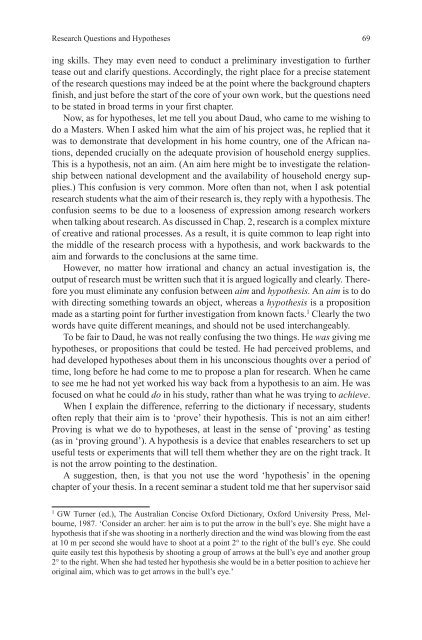How-to-Write-a-Better-Thesis
Create successful ePaper yourself
Turn your PDF publications into a flip-book with our unique Google optimized e-Paper software.
Research Questions and Hypotheses<br />
69<br />
ing skills. They may even need <strong>to</strong> conduct a preliminary investigation <strong>to</strong> further<br />
tease out and clarify questions. Accordingly, the right place for a precise statement<br />
of the research questions may indeed be at the point where the background chapters<br />
finish, and just before the start of the core of your own work, but the questions need<br />
<strong>to</strong> be stated in broad terms in your first chapter.<br />
Now, as for hypotheses, let me tell you about Daud, who came <strong>to</strong> me wishing <strong>to</strong><br />
do a Masters. When I asked him what the aim of his project was, he replied that it<br />
was <strong>to</strong> demonstrate that development in his home country, one of the African nations,<br />
depended crucially on the adequate provision of household energy supplies.<br />
This is a hypothesis, not an aim. (An aim here might be <strong>to</strong> investigate the relationship<br />
between national development and the availability of household energy supplies.)<br />
This confusion is very common. More often than not, when I ask potential<br />
research students what the aim of their research is, they reply with a hypothesis. The<br />
confusion seems <strong>to</strong> be due <strong>to</strong> a looseness of expression among research workers<br />
when talking about research. As discussed in Chap. 2, research is a complex mixture<br />
of creative and rational processes. As a result, it is quite common <strong>to</strong> leap right in<strong>to</strong><br />
the middle of the research process with a hypothesis, and work backwards <strong>to</strong> the<br />
aim and forwards <strong>to</strong> the conclusions at the same time.<br />
<strong>How</strong>ever, no matter how irrational and chancy an actual investigation is, the<br />
output of research must be written such that it is argued logically and clearly. Therefore<br />
you must eliminate any confusion between aim and hypothesis. An aim is <strong>to</strong> do<br />
with directing something <strong>to</strong>wards an object, whereas a hypothesis is a proposition<br />
made as a starting point for further investigation from known facts. 1 Clearly the two<br />
words have quite different meanings, and should not be used interchangeably.<br />
To be fair <strong>to</strong> Daud, he was not really confusing the two things. He was giving me<br />
hypotheses, or propositions that could be tested. He had perceived problems, and<br />
had developed hypotheses about them in his unconscious thoughts over a period of<br />
time, long before he had come <strong>to</strong> me <strong>to</strong> propose a plan for research. When he came<br />
<strong>to</strong> see me he had not yet worked his way back from a hypothesis <strong>to</strong> an aim. He was<br />
focused on what he could do in his study, rather than what he was trying <strong>to</strong> achieve.<br />
When I explain the difference, referring <strong>to</strong> the dictionary if necessary, students<br />
often reply that their aim is <strong>to</strong> ‘prove’ their hypothesis. This is not an aim either!<br />
Proving is what we do <strong>to</strong> hypotheses, at least in the sense of ‘proving’ as testing<br />
(as in ‘proving ground’). A hypothesis is a device that enables researchers <strong>to</strong> set up<br />
useful tests or experiments that will tell them whether they are on the right track. It<br />
is not the arrow pointing <strong>to</strong> the destination.<br />
A suggestion, then, is that you not use the word ‘hypothesis’ in the opening<br />
chapter of your thesis. In a recent seminar a student <strong>to</strong>ld me that her supervisor said<br />
1<br />
GW Turner (ed.), The Australian Concise Oxford Dictionary, Oxford University Press, Melbourne,<br />
1987. ‘Consider an archer: her aim is <strong>to</strong> put the arrow in the bull’s eye. She might have a<br />
hypothesis that if she was shooting in a northerly direction and the wind was blowing from the east<br />
at 10 m per second she would have <strong>to</strong> shoot at a point 2° <strong>to</strong> the right of the bull’s eye. She could<br />
quite easily test this hypothesis by shooting a group of arrows at the bull’s eye and another group<br />
2° <strong>to</strong> the right. When she had tested her hypothesis she would be in a better position <strong>to</strong> achieve her<br />
original aim, which was <strong>to</strong> get arrows in the bull’s eye.’














![[Lonely Planet] Sri Lanka](https://img.yumpu.com/59845622/1/169x260/lonely-planet-sri-lanka.jpg?quality=85)


